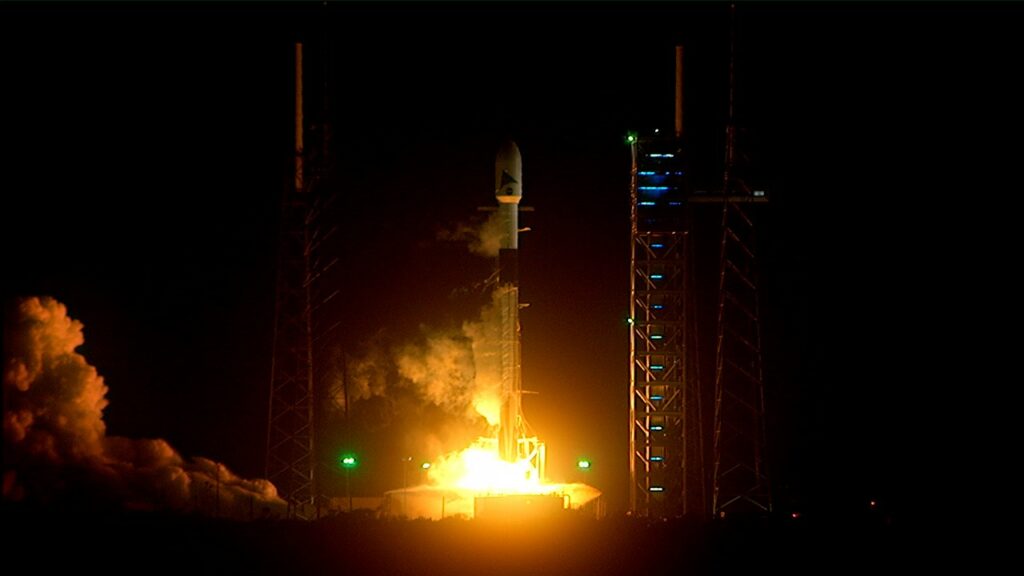NASA’s Plankton, Aerosol, Climate, ocean Ecosystem (PACE) satellite successfully launched and reached on Thursday, February 10th. The mission took off from Space Launch Complex 40 at Cape Canaveral Space Force Station in Florida, at 1:33 am EST 10:33 pm (PST) atop a SpaceX Falcon 9 rocket. About five minutes after launch, NASA confirmed that ground stations on Earth had acquired a signal from the satellite and were receiving data on its operational status and capabilities post-launch. For the next three years, the mission will monitor Earth’s ocean and atmosphere and study the effects of climate change.
Specifically, PACE was designed to study how the ocean and atmosphere exchange carbon dioxide and how microscopic particles (aerosols) in our atmosphere might fuel phytoplankton growth in the ocean. The data it accumulates will be used to identify the extent and duration of harmful algae blooms and extend NASA’s long-term observations of our changing climate. As NASA Administrator Bill Nelson expressed in an agency press release:
“Congratulations to the PACE team on a successful launch. With this new addition to NASA’s fleet of Earth-observing satellites, PACE will help us learn, like never before, how particles in our atmosphere and our oceans can identify key factors impacting global warming. Missions like this are supporting the Biden-Harris Administration’s climate agenda and helping us answer urgent questions about our changing climate.”

The satellite will perform oceanic measurements using its hyperspectral ocean color instrument, allowing researchers to study oceans and bodies of water in the visible, ultraviolet, and near-infrared wavelengths. This will enable scientists to track the distribution of phytoplankton and determine which communities are present on a daily, global scale from space. This will be a first for scientists and coastal resource managers, who will use the data to forecast the health of fisheries, track harmful algal blooms, and identify changes in the marine environment.
The spacecraft also carries the Hyper-Angular Rainbow Polarimeter 2 (HARP2), a wide-angle imaging polarimeter designed to measure aerosol particles and clouds, as well as properties of land and water surfaces; and the Spectro-polarimeter for Planetary Exploration (SPEX), a compact remote sensing instrument for measuring and characterizing aerosols in the atmosphere. These will detect how sunlight interacts with particles in the atmosphere and allow scientists to measure air quality on local, regional, and global scales.
Said Karen St. Germain, the director of the Earth Science Division, part of the Science Mission Directorate at NASA Headquarters:
“Observations and scientific research from PACE will profoundly advance our knowledge of the ocean’s role in the climate cycle. The value of PACE data skyrockets when we combine it with data and science from our Surface Water and Ocean Topography mission – ushering in a new era of ocean science. As an open-source science mission with early adopters ready to use its research and data, PACE will accelerate our understanding of the Earth system and help NASA deliver actionable science, data, and practical applications to help our coastal communities and industries address rapidly evolving challenges.”

One of the chief concerns about climate change is how Earth’s oceans are affected by rising temperatures and increased air pollution. This includes rising sea levels, increased acidity, loss of habitats (like coral reefs) and biodiversity. With PACE, scientists can study how phytoplankton populations are also affected, which play a key role in the global carbon cycle. These organisms absorb carbon dioxide from the atmosphere and convert it into their cellular material, which drives larger aquatic global ecosystems that provide critical resources for countless species (including humans).
“It’s been an honor to work with the PACE team and witness firsthand their dedication and tenacity in overcoming challenges, including the global pandemic, to make this observatory a reality,” said Marjorie Haskell, the PACE program executive at NASA Headquarters. “The passion and teamwork are matched only by the excitement of the science community for the data this new satellite will provide.”
“After 20 years of thinking about this mission, it’s exhilarating to watch it finally realized and to witness its launch. I couldn’t be prouder or more appreciative of our PACE team,” added Jeremy Werdell, a PACE project scientist at NASA’s Goddard Space Flight Center. “The opportunities PACE will offer are so exciting, and we’re going to be able to use these incredible technologies in ways we haven’t yet anticipated. It’s truly a mission of discovery.”
Further Reading: NASA

